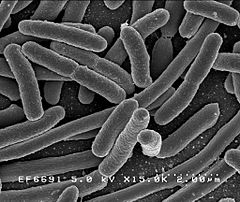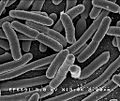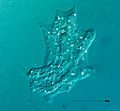Organism facts for kids
Quick facts for kids Life on EarthTemporal range: Late Hadean (?) – Recent
|
|
|---|---|
 |
|
| These Escherichia coli cells provide an example of a prokaryotic microorganism | |
| Scientific classification | |
| (unranked): |
Life on Earth
|
An organism is any living thing. It's usually easy to spot a living thing, like a plant or an animal. Organisms are the living parts of our environment. Things like rocks or sunshine are non-living parts.
Contents
What Organisms Need to Live
Most organisms need a few basic things to survive. They need air, water, nutrients (which is like food), energy, and a place to live. However, not all living things need all these at the same time. For example, some tiny organisms don't need air at all!
Are Viruses Alive?
Viruses are a bit tricky. Scientists don't fully agree if they are truly "living" or not. Viruses are made of protein and nucleic acid, and they can evolve over time. This evolution is a very important sign of life.
However, viruses have two main phases. One phase is inactive, like a tiny package. The other phase is very active, but only when the virus is inside a living cell of another organism. When inside a cell, they reproduce quickly. Think of it like a computer program. It's active when you run it, but just a file when it's not in use. It's still a program, right?
Tiny and Giant Organisms
Some organisms are huge, like giant trees or whales. They are made of millions of tiny parts called cells. We call them multicellular organisms. You can see them easily without any special tools.
Other organisms are so small you need a microscope to see them. These are called microorganisms. Many microorganisms are made of just one cell. They are called unicellular organisms or single-celled organisms. Good examples include bacteria, and tiny creatures like the Amoeba and Paramecium.
The Tree of Life
Scientists have a big project called the Tree of Life. They are trying to figure out how all living things are related to each other. One of their main goals is to find the LUCA. LUCA stands for the "Last Universal Common Ancestor." This was the very first living thing from which all other life on Earth descended.
Scientists believe LUCA lived about 3.8 billion years ago. This idea comes from Charles Darwin's famous book, On the Origin of Species. He suggested that all living things on Earth probably came from one original life form.
Images for kids
-
The bacterium Escherichia coli (E. coli), is a single-celled prokaryote
-
Polypore fungi and angiosperm trees are large multicellular eukaryotes.
-
Precambrian stromatolites in the Siyeh Formation, Glacier National Park. In 2002, a paper in the scientific journal Nature suggested that these 3.5 Gya (billion years old) geological formations contain fossilized cyanobacteria microbes. This suggests they are evidence of one of the earliest known life forms on Earth.
See also
 In Spanish: Ser vivo para niños
In Spanish: Ser vivo para niños







